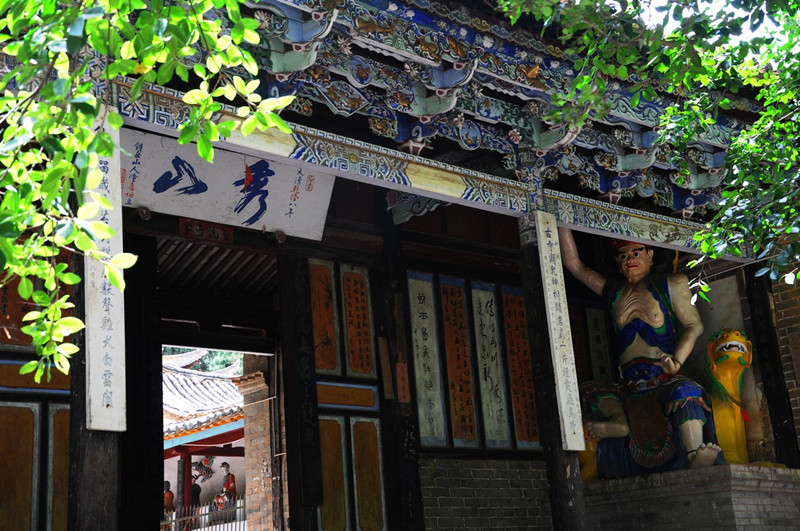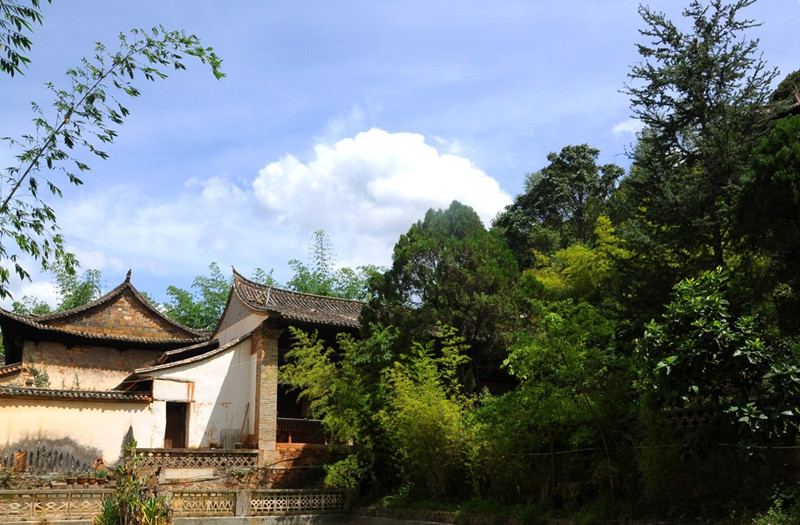
Xiushan Temple in Shiping County, Honghe
Introduction
Xiushan Temple (秀山寺), located 15 kilometers southwest of Shiping County (石屏县) in Honghe Hani and Yi Autonomous Prefecture (红河哈尼族彝族自治州), Yunnan Province (云南省), is a historical temple with roots tracing back to the Tang Dynasty (唐朝). Originally named Zhenjue Temple (真觉寺), it was renamed Xiushan Temple during the late Ming Dynasty (明朝). This ancient architectural complex is not only a site of serene beauty but also a remarkable fusion of Buddhism, Daoism, and Confucianism.
Geography and Climate
Honghe Hani and Yi Autonomous Prefecture is situated on the southern Yunnan-Guizhou Plateau, characterized by varied topography, including limestone mountains, plateaus, valleys, basins, and hills. The region has significant elevation differences and a complex landscape. It enjoys ample rainfall and abundant sunlight, with a mild annual temperature range. The climate is classified as a humid subtropical plateau monsoon climate, making it suitable for diverse flora and fauna.
Temple Overview
Historical Significance
Xiushan Temple is the oldest temple in Shiping, covering an area of 1,826 square meters. The temple complex consists of several structures, including the mountain gate, front hall, middle hall, main hall, and side halls. Notably, in 1924, the prominent local figure Chen Heting (陈鹤亭) initiated the construction of Lingyun Pavilion (凌云阁) adjacent to the temple, enhancing the historical significance of the site.
Architectural Features
According to the Qing Dynasty (清) records, “Xiushan Temple was founded in the Tang Dynasty and originally named Zhenjue Temple.” Its name was changed to Xiushan Temple due to its elevated position on Xiushan Mountain (秀山).
The entrance features a grand inscription of “Xiushan” (秀山) in powerful calligraphy. Upon entering, visitors can find a serene courtyard surrounded by various flowering trees, such as cherry blossoms (唐樱), plum trees (宋梅), and an ancient Araucaria (罗汉松) believed to be over 600 years old. This tree was originally transplanted by the famous traveler Xu Xiake (徐霞客) during his exploration of the southern Yangtze River (南盘江) source.
Unique Features
To the left of the Araucaria is an 800-year-old plum tree. Despite its gnarled trunk, the tree produces abundant blossoms, releasing a subtle fragrance that enhances the peaceful atmosphere. This tree serves as a reminder of resilience, having survived through centuries of challenges.
In front of the main hall, visitors will encounter a statue of Maitreya Buddha (弥勒佛). The couplet accompanying the statue reads: “Loyal to the country, loving the people; why should a righteous person not worship the divine?” This inscription encourages visitors to reflect on their moral integrity and the importance of loyalty and love in life.
Temple Surroundings
Natural Beauty
The temple is surrounded by lush greenery, including bamboo groves and a variety of trees that bloom in different seasons. The wintersweet (腊梅) tree, renowned for its fragrant yellow blossoms, adds to the temple’s charm, especially in winter.
Visitors can stroll through the temple grounds and appreciate the harmonious blend of nature and spirituality. The tranquility of the environment makes it an ideal location for meditation and reflection.
Cultural Heritage
Inside the middle hall, statues of the founders of Buddhism, Confucianism, and Daoism—Shakyamuni (释迦牟尼), Confucius (孔子), and Laozi (老子)—are prominently displayed. These figures symbolize the cultural and philosophical richness of the region during the Ming and Qing Dynasties.
The courtyard of the main hall features over a century-old flowering plum tree (青梅), golden osmanthus (金桂), and camellias (山茶). The lush greenery and blooming flowers create a serene atmosphere that evokes a sense of tranquility and spirituality.
Couplets and Philosophy
On a small door to the left of the main hall hangs a thought-provoking couplet: “Not vulgar is the immortal’s bone; emotional is the Buddha’s heart,” with the horizontal inscription reading “High Aspiration.” This couplet conveys a deep life philosophy, emphasizing the importance of authenticity and genuine appreciation of life’s experiences.
The ideal life state, as suggested by the couplet, is a perfect balance between the qualities of the “immortal” and the “Buddha.” This reflects the understanding that one should neither become detached from the world nor become lost in its distractions.
Ancient Blossoms
Near the main hall stands the ancient wintersweet tree, known for its rich fragrance and resilience through the ages. The unknown origins of its planting add to its mystique, and it stands as a testament to the beauty of nature and endurance.
Nature and Companionship
The temple grounds are alive with the sounds of nature. Birds flit among the flowers, singing joyful melodies that enhance the tranquil ambiance. These birds seem to share a special connection with the ancient plum tree, providing companionship throughout the seasons.
Conclusion
The vibrant blossoms and picturesque scenery of Xiushan Temple create an enchanting atmosphere, making it a perfect place for contemplation and appreciation of nature’s beauty. Xiushan Temple not only represents a cultural gem of Yunnan but also offers a unique experience for visitors seeking spiritual and historical enrichment.
How to Get There
To reach Xiushan Temple, you can take a bus from Shiping County to Xiushan Mountain. Taxis and private cars are also available for a more direct route. The journey provides beautiful views of the surrounding landscapes, making it an enjoyable trip.
Travel Tips
- Best Time to Visit: Spring and autumn are ideal for enjoying mild weather and blooming flowers.
- Comfortable Footwear: Wear comfortable shoes for walking along the hilly paths.
- Photography: Bring a camera to capture the stunning natural beauty and intricate architectural details.
- Respect the Environment: Maintain the cleanliness of the temple grounds and be respectful of the spiritual atmosphere.
- Local Cuisine: Consider trying local dishes in Shiping County to enhance your cultural experience during your visit.



 7 Days GolfingTour
7 Days GolfingTour
 8 Days Group Tour
8 Days Group Tour
 8 Days Yunnan Tour
8 Days Yunnan Tour
 7 Days Shangri La Hiking
7 Days Shangri La Hiking
 11 Days Yunnan Tour
11 Days Yunnan Tour
 6 Days Yuanyang Terraces
6 Days Yuanyang Terraces
 11 Days Yunnan Tour
11 Days Yunnan Tour
 8 Days South Yunnan
8 Days South Yunnan
 7 Days Tea Tour
7 Days Tea Tour
 8 Days Muslim Tour
8 Days Muslim Tour
 12 Days Self-Driving
12 Days Self-Driving
 4 Days Haba Climbing
4 Days Haba Climbing
 Tiger Leaping Gorge
Tiger Leaping Gorge
 Stone Forest
Stone Forest
 Yunnan-Tibet
Yunnan-Tibet
 Hani Rice Terraces
Hani Rice Terraces
 Kunming
Kunming
 Lijiang
Lijiang
 Shangri-la
Shangri-la
 Dali
Dali
 XishuangBanna
XishuangBanna
 Honghe
Honghe
 Kunming
Kunming
 Lijiang
Lijiang
 Shangri-la
Shangri-la
 Yuanyang Rice Terraces
Yuanyang Rice Terraces
 Nujiang
Nujiang
 XishuangBanna
XishuangBanna
 Spring City Golf
Spring City Golf
 Snow Mountain Golf
Snow Mountain Golf
 Stone Mountain Golf
Stone Mountain Golf

















